MOBIS-COVID19
Results as of 09/10/2023 (Fourth wave)
A Project of IVT, ETH Zurich and WWZ, University of Basel
This work is licensed under Creative Commons. 
Contact: Daniel Heimgartner (daniel.heimgartner@ivt.baug.ethz.ch)
Previous and future reports can be found at: https://ivtmobis.ethz.ch/mobis/covid19/en
1 News
7 Dec:
- The conclusions have been updated
8 June:
- Some graphs have been extended to display the full range of data points from October 2019 onwards.
- The sociodemographic graphs have been smoothed to improve interpretability. The un-smoothed data is still available at the download link.
- New home office analysis. link
- Unification of the color scheme and wider graphs.
31 May:
- Due to regional differences in the regional composition between the Link and original MOBIS panels, the report has been adjusted to only include participants who meet the original MOBIS eligibility criteria. Forthcoming analysis will include all participants where a comparison with 2019/20 is not needed.
25 January:
- There have been significant changes since the last report.
- Since Nov. 12, a co-operation with the company LINK has allowed us to increase the size of our panel. The results now include these new participants, and the changes to the panel distribution are indicated here: link
- This does mean changes to some of the graphs from November onwards - due to the new sample composition.
- The results of online surveys on changes to participants’ employment and household statuses have been integrated into the results.
14 December:
- Most charts are now interactive. The effects of the winter weather are now clearly visible.
Previous news (click to expand)
18 November:
- Charts 2-6 are now interactive and zoomable.
2 November:
- The method for the calculation of active days was improved, which affects some of the results.
- New graph of average daily distance by trip purpose. link
6 October:
- The chart showing the daily average distance by gender has been corrected to show total distance, whereas it previously included only car travel. Also the same graph now dispalys a 4 day rolling average for visibility. The original values are still available in the downloadable data.
28 September:
- New chart with key transport-mode indicators added. link
24 August:
- Updated conclusions.
- The report will now be updated every second week.
11 August:
- New analysis of trip purpose (mode shares and hourly counts). link
- Weekly weights of the sample against the original MOBIS study have been applied to all results. link
6 August:
- Added breakdown of the current sample to the section Differences in the distributions
13 July:
- As of July 6th, face masks are compulsory on public transport in Switzerland.
- To reflect this development, the relevant graphs have vertical lines added indicating the start of the lockdown (March 16th), relaxation of the lockdown (May 11th) and the introduction of the mask requirement (July 6th).
29 June:
- New analysis on the shifts in the transport mode share - link
15 June:
- The data can now be downloaded directly for certain requested charts. Please make sure to cite both the IVT, ETHZ and WWZ, Uni Basel as the source.
- Hourly counts now show the whole day - Midnight to 4am is no longer excluded.
- Analysis by home office - link.
- In response to multiple inquiries, we would like to clarify that the baseline-2019 period covers September and October 2019.
- Results by gender corrected
- New analysis of car travel speeds by distance class - link.
25 May:
- Adjusted # Activities/Day so that the first home activity per day is not included.
- Converted long tables to graphs.
18 May:
- First report after the relaxation of lockdown measures on May 11th.
- The 2019 Baseline period has been shortened to only include September and October - This mostly affects the cycling numbers.
11 May:
- New graph of activity space and daily radius - link.
4 May:
- New chart from online survey with participants on risk perception - link.
- Key points summary and formatting adjustments.
27 April:
- New chart on the change in activity type by land zoning.
20 April:
- Mobile participants per day.
- Non-mobile participants are now included in the activity-space numbers in addition to a new table on median weekly activity spaces.
- New graphs, including average trip distance by mode.
- Formatting improvements and other small corrections.
13 April:
- Earlier weeks have been grouped and colored grey in certain graphs.
2 Introduction
On March 16, 2020, 3700 participants who completed the MOBIS study between September 2019 and January 2020 were invited to reinstall the GPS Logger and Travel Diary App ‘Catch-My-Day’, developed by MotionTag. This voluntary recording of their mobility behaviour allowed us to track the impact of the various special measures during the unfolding pandemic. The pandemic is still going on one year later and many participants are still tracking.
The results are shown in comparison to those of the first weeks of mobility data from the original MOBIS Study which were recorded between 1st September and 1st November 2019, and thus serve as a baseline well before the pandemic hit Switzerland. Only trips inside Switzerland are currently considered, although data on cross border travel is available.
Participation decreased from about 1’300 participants to around 500 by the start of the second COVID19 wave in autumn/fall 2020 for any number of good reasons, such as a new smartphone, operating system updates, etc.. About 250 rejoined the panel after a second invitation in October 2020. We are very grateful for their engagement. Still, we happily agreed, when LINK offered to recruit more participants to the panel. This further increase of our sample allows us to complement the existing core. By mid-January a total of 393 additional participants had joined via LINK.
For the MOBIS study, participants were only eligible if they used a car at least 3 days a week - which skews the sample away from the Swiss general population. We did not impose a similar condition on the LINK-recruited participants as we are now aiming towards a more representative sample of the population. However, this means that the sample as of 2021 is no longer comparable to 2019 and 2020, as the mobility behaviour is quite different between the two groups. As such, for any analyses which makes comparisons to the pre-pandemic era, only link participants who meet the MOBIS-criteria are included.
The number of tracking participants each day used to calculate the average daily values, includes all participants who recorded tracks before or after that date. This allows the consideration of those who stay at home while still allowing for survey dropouts.
The GPS Travel diary used, Catch-My-Day (for iOS and Android) can have a 2-3 day delay before the tracks are available for analysis. The scaling by active participants accommodates for this, but the results of previous reports may change when the report is updated. The scales are calculated against the representative sample we obtained as part of the MOBIS recruitment process.
The colors in the graphs below are selected to indicate transport mode groupings. The greens indicate active modes, and the blue/purples public transport. brown is Car, and black is the total. These colors are consistent through following transport mode related graphs.
3 Average daily distance
Here, the average daily distance travelled by participants is presented, differentiated by gender. To aid readability, a 7-day rolling average is used. The clear reduction in travel caused by the lockdown at the start of the pandemic is visible, as well as the gradual increase over the following months. The amount of travel is slowly recovering to pre-pandemic levels, as seen during the relatively normal period before the second wave in Autumn 2020.
[1] “Download chart data”
4 Active days
llustrated below is the number of participants who are ‘mobile’ on a particular day. That means that they logged some travel in the Catch-my-day app, even a short walk. The downward spikes indicate the weekends. The 7-day rolling average is given by the black line, which shows relative stability since the end of the first lockdown. This is the case even during the second partial lockdown. Various small variations are driven primarily by public holidays where people remain at home.
[1] “Download chart data”
5 Change in kilometers travelled by transport mode
Here we see the breakdown by travel mode. The values are given relative to the pre-pandemic behavior, calculated based on the average from September and October 2019. Particularly evident is the large increase in cycling observed during the lockdown, which was sustained throughout the summer of 2020. Public transport usage collapsed during the lockdown and recovered much more slowly than other modes. It is still at around only 50% of pre-pandemic levels.
Also presented in this section is a stacked version of this graph, with public transport modes grouped together. This graph makes it evident how the overall mode share has changed, with driving and cycling taking modal share away from public transport.
[1] “Download chart data”
The following two figures present regression estimates based on a Poisson model. Such a model can be used to estimate the average proportional change in a variable of interest while controlling for confounding factors. We control for weather effects and person fixed effects to absorb unobserved heterogeneity that is constant across time. The vertical lines or the colored bands mark the 90%-confidence intervals.
[1] “Download chart data”
6 Key indicators by mode
This section presents additional indicators by mode, in addition to the daily distance that matches the previous graphs in section 5. Again, these graphs present the percentage change when compared to the baseline period in 2019. Particularly interesting is the variation in trip distance. Walk trips during the lockdown were much longer, but this behavior wasn’t sustained afterwards. On the other hand, bus trips have become shorter since the start of the pandemic, potentially driven by home-office trend.
[1] “Download chart data”
7 Sociodemographics
The graphs below present the change in average daily kilometers by various sociodemographic variables. The lines have been smoothed to improve readability. For some demographics, be aware that there are however only a small number of participants (see the distributions section). The difference by household size during and after the lockdown are particularly interesting, as is the behavior of the 25-35 age group in summer 2020. During the first lockdown higher income groups reduced their daily travel more.
7.1 Age
7.2 Education
7.3 Employment status
7.4 Gender
7.5 Household Size
7.6 Monthly Income
7.7 Correspondence Language
7.8 Access to car
8 Analysis of trip purpose
The purpose of each trip is taken from the activity performed at the destination of the trip. The purpose was imputed using a random forest model, using training data from those who voluntarily recorded the purpose of their activities. Some trip purposes show a larger shift in modal split than others. For shopping, during 2020, cycling became more popular for going to the shops. Grocery shopping and discretionary shopping are not differentiated. The train is almost never taken to go shopping, whereas local public transport is still used.
For commuting, public transport usage lost most of its share during the lockdown. Since the lockdown walking has a continually increasing share, which can mostly likely be attributed to the shift towards home office and the resulting fewer work trips.
[1] “Download chart data”
8.1 Assistance
8.2 Education
8.3 Errand
8.4 Home
8.5 Leisure
8.6 Other
8.7 Shopping
8.8 Work
9 Road travel speeds
The following graph shows the effect of the COVID-19 crisis on median car travel speeds during the week, i.e. excluding weekends and holidays. During the lockdown period from March 16th to May 11th, an increase in the peak-hour speeds was observed, indicating a decrease in overall congestion. Since the relaxation of the measures, peak-hour speeds have returned to pre-COVID-19 values, a sign that congestion is back to usual levels.
10 Shifts in the transport mode share
A ternary plot is the graphical representation of triplets of numerical data. It is suitable for representing a constant sum, which is broken down into three summands. The following figure shows an example of such a plot with a single point. The triplet corresponding to this point can be read by following the green lines: A=0.5, B=0.3 and C=0.2. The sum of the three values is equal to 1.
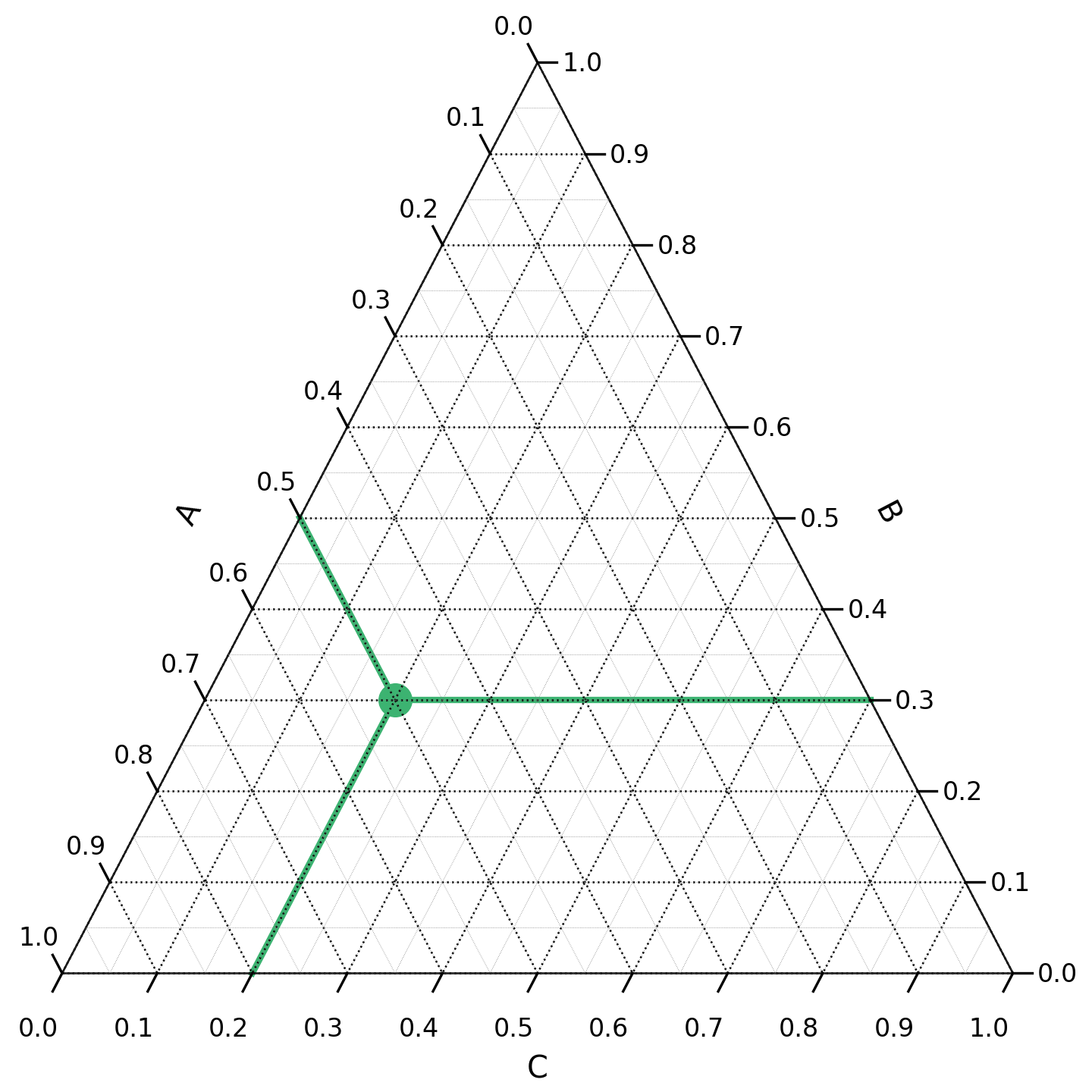
The following ternary plots show the change in mode shares over the course of the COVID-19 crisis, for different types of public transport subscriptions (GA, Halbtax and other). The modes are grouped into the following categories:
- Motorized individual transport (car, motorbike, taxi, Uber)
- Public transport (bus, tram, ferry, metro, train)
- Unmotorized transport (walk, bike)
During the lockdown, a higher share of kilometers and trips were performed using motorized individual and unmotorized modes as compared to the reference period. After the lockdown, the share of public transport has increased and the share unmotorized modes has decreased, both slightly. The share of motorized individual modes it still greater than during the reference period.
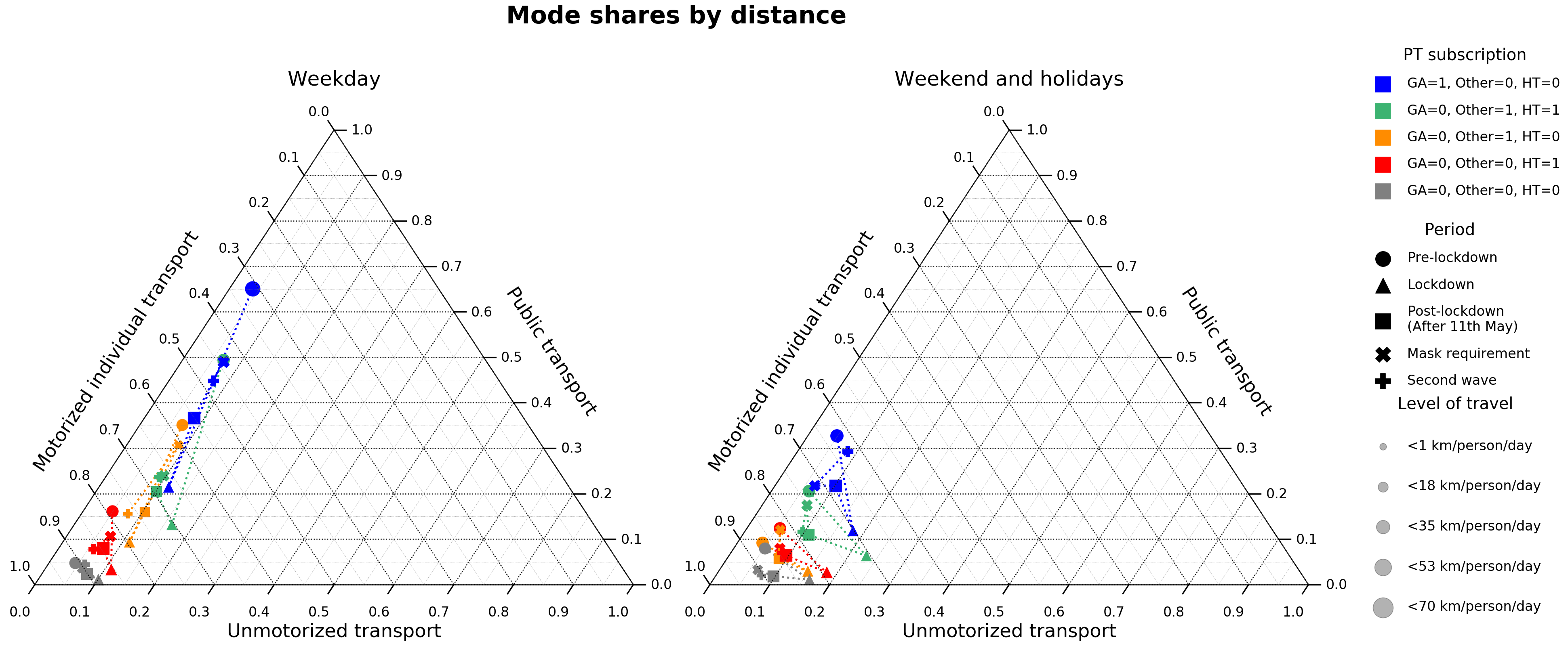
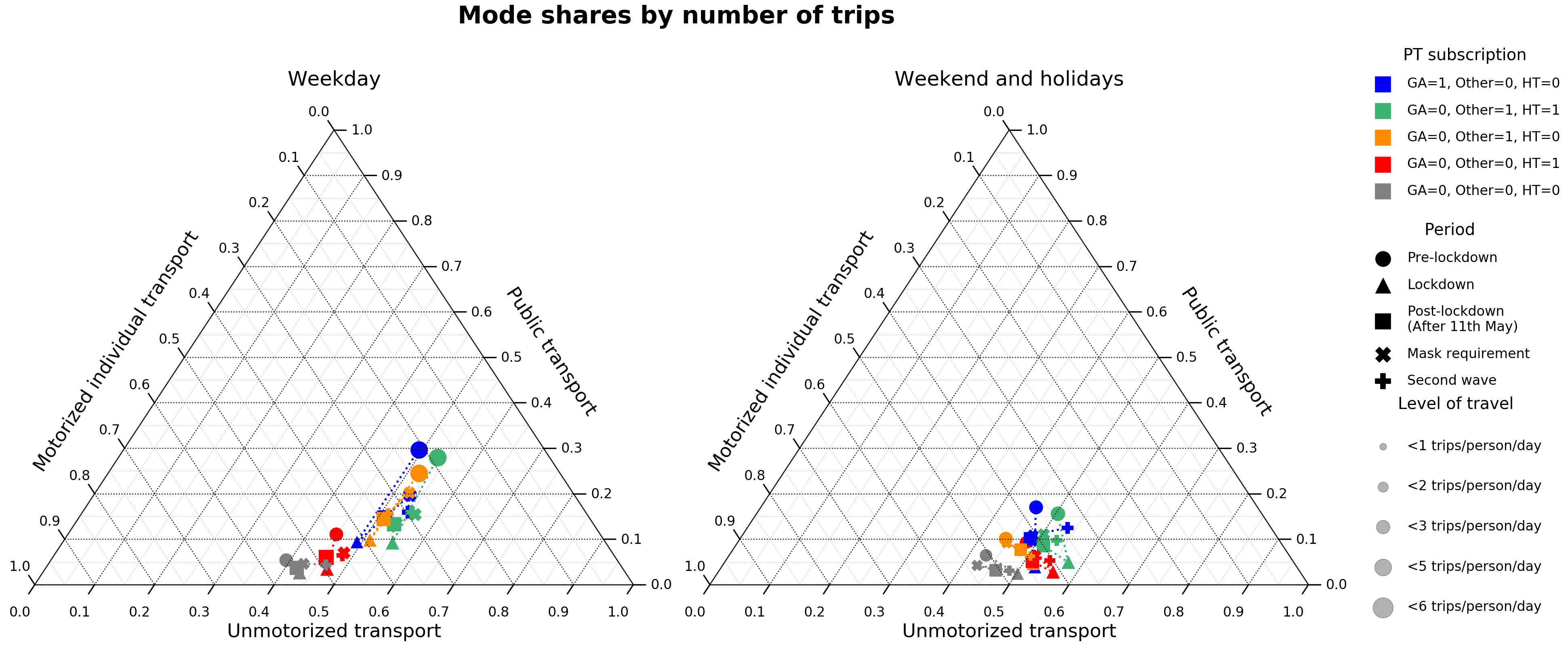
11 Reduction in kilometers travelled by working arrangement
Participants in MOBIS-Covid19 were asked to indicate their current working situation on multiple occasions using short online questionnaires, with the understanding that this can change frequently. The following charts use these results. For those that didn’t respond, the first response from the MOBIS study is retained. Specifically, we asked for the number of days working both at home and out of home, and these were then grouped into the categories used below:
- Working only at home
- Only working out of home
- A mix of home office and normal conditions
We also asked if they were assigned to Kurzarbeit (Furlough), though this was last updated at the end of 2020.
The first chart shows the percent of working participants working outside of home, on a 7-day rolling average. The difference between those allowed to do home office, and those who cannot is very clear. However, even the non-home-office group is not commuting nearly as much as pre-pandemic, as the economy is not yet fully open. There is still some evident resistance to returning to the office for home-office workers.
[1] “Download chart data”
12 Reduction in kilometers travelled by canton
The grid of Cantonal charts shows the reductions in daily average kilometers by Canton of the home postcode. Cantons are the regional level of government in Switzerland. Where a postcode overlaps multiple Cantons, the Canton with the largest areal share of the postcode is assigned. Only cantons with enough participants are shown (N > 5). The data are smoothed over 6 weeks. The dashed grey line indicates the overall average. In particular, Geneva stands out for its lack of mobility reductions compared to other cantons.
[1] “Download chart data”
13 Trip duration by transport mode and gender
For some modes, there are differences in the average trip duration between genders. In particular, men tend to cycle longer, and also drive longer as well. For cycling, the trip length increased during the lockdown, and while it reduced after measures were relaxed, it remains elevated compared to before the pandemic, even taking the winter months into account. For Car and Train, the difference in trip duration between the genders has been reduced dramatically.
[1] “Download chart data”
14 Average stage length by transport mode (km)
The trends by mode for the stage length are not as clear. All modes except cycling and walking saw a reduction in the average stage length (in Kilometers) during the lockdown.
[1] “Download chart data”
15 Activity space and daily travel radius
The activity space is an attempt to describe the space, which a person regularly performs most of their activities. A commonly used measure of this activity space is the 95% confidence ellipse of the activity locations, in this case weighted by duration. In the following analysis, the activities at the home location are included, for those that had the app activated on that day. This is an important metric which gives an idea of the area in which travel is being performed. The daily travel radius is also presented. Here we use the radius of the activity space ellipse (on the largest axis).
In the first chart, a large increase in the activity space after the lockdown is evident, as a ‘compensation’ for the lockdown during the time when most facilities were closed. In the second graph, the distribution of activity spaces is presented. A value of 1mˆ2 essentially means that the participant stayed at home. Also evident is that while many stayed at home during the lockdown (the left blip in dotted-black), many were still relatively mobile. Since the lockdown, the average activity space has been increasing slowly, but is still far below the pre-pandemic distribution (red).
The third chart shows how the median activity space varied over time by age group. The mobility of the younger groups post lockdown is evident.
[1] “Download chart data”
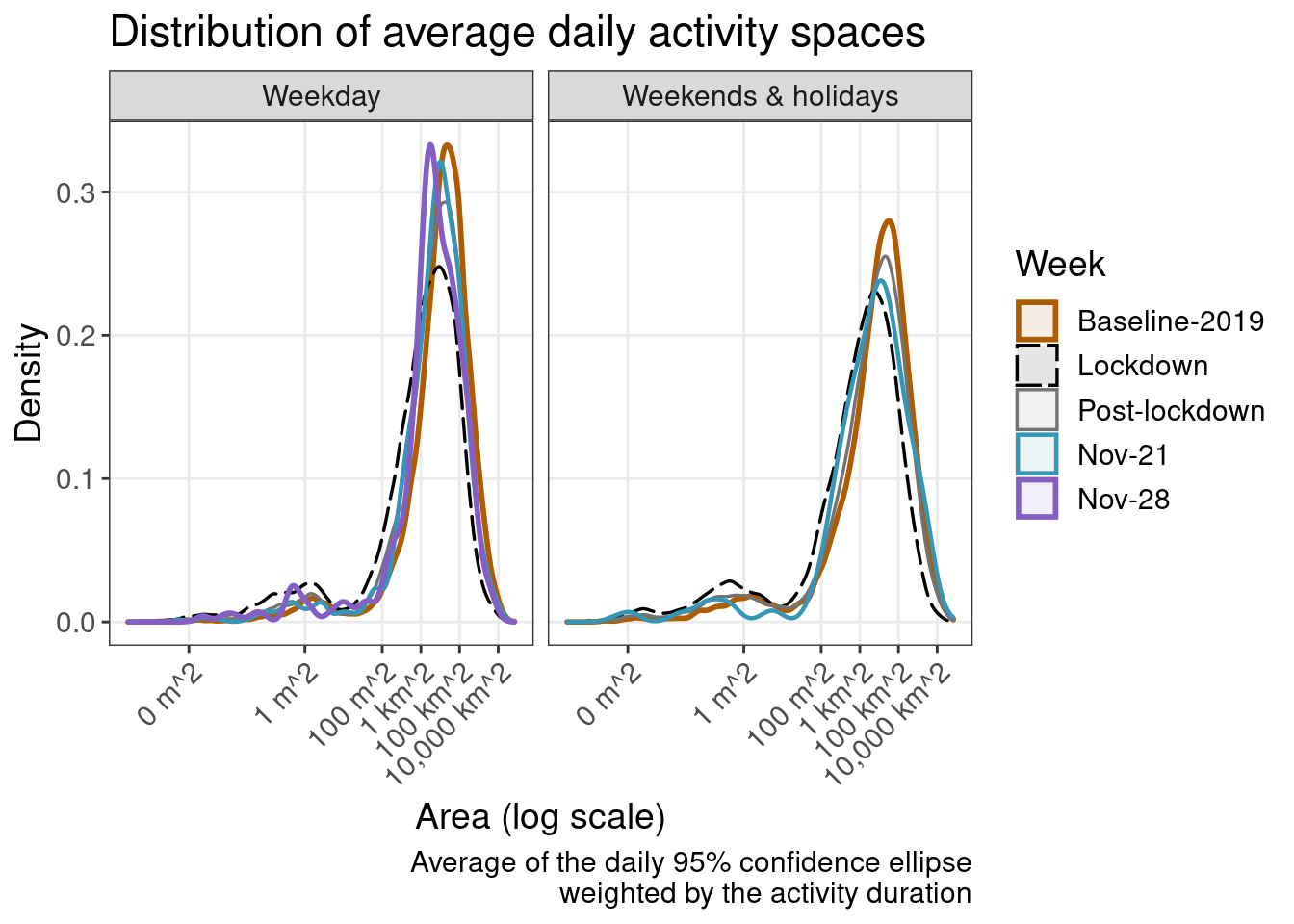
16 Hourly counts
The number of trips started per hour. The y axis is normalized by the maximum hourly value in the graph.
17 Participation
18 Risk perception
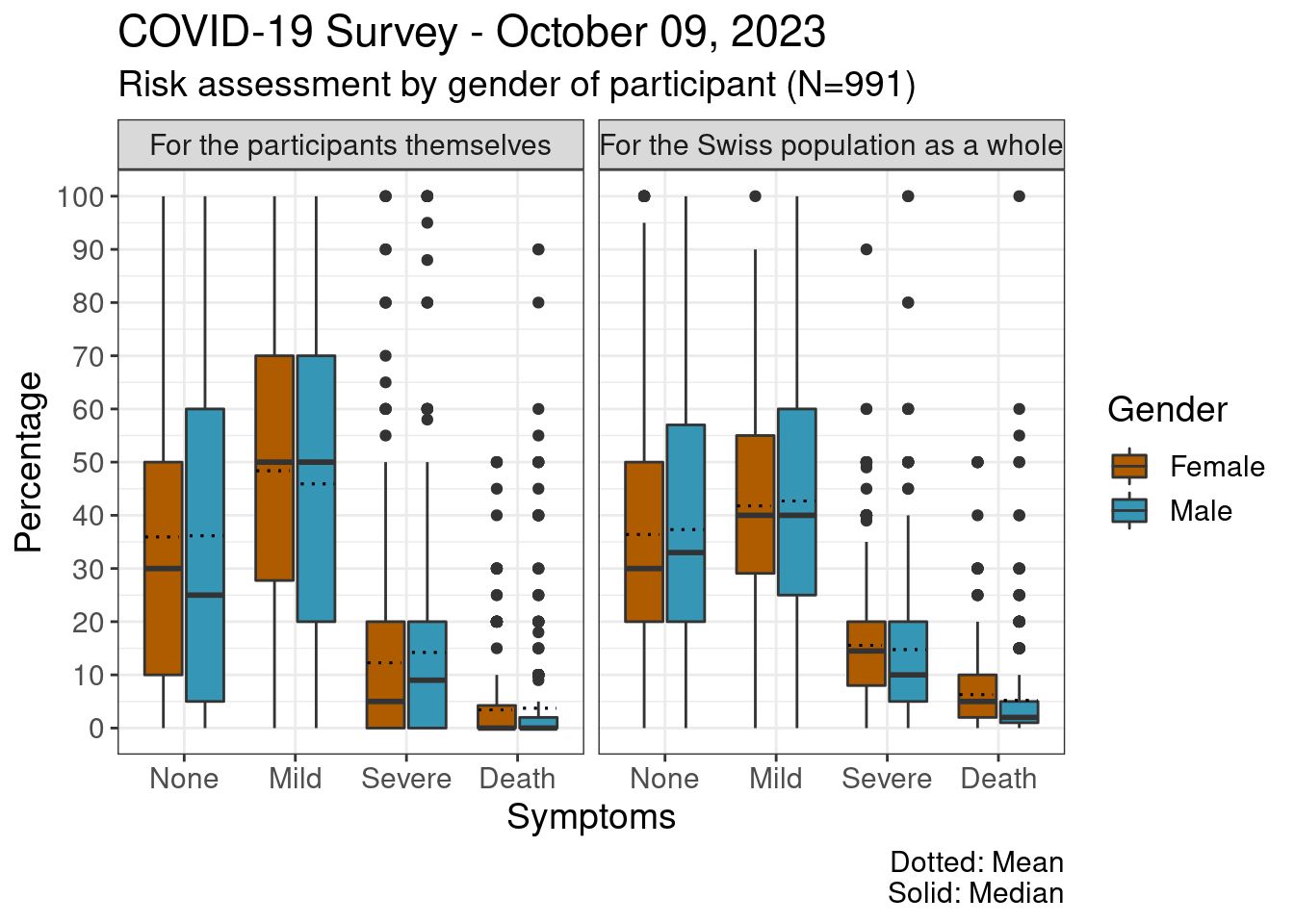
A first analysis from the survey on risk perception in the case of a COVID-19 infection shows that participants evaluate the risks of various outcomes differently for themselves and the Swiss population. The possibility that the participant experiences severe symptoms that require hospitalisation or fatal symptoms is considered somewhat lower by the participants for themselves than for the Swiss population. Both men and women appear to overestimate the probability of death by expecting the “asymptomatic” course to be less likely. While the median values for the various symptom categories do not differ greatly between men and women, the range of values for men is somewhat wider than for women
19 Differences in the distributions
The following charts show the characteristics of the MOBIS:COVID-19 sample compared to the original MOBIS Sample. There are some small differences, but generally the samples are consistent. This chart will be extended to compare to the relevant census data.


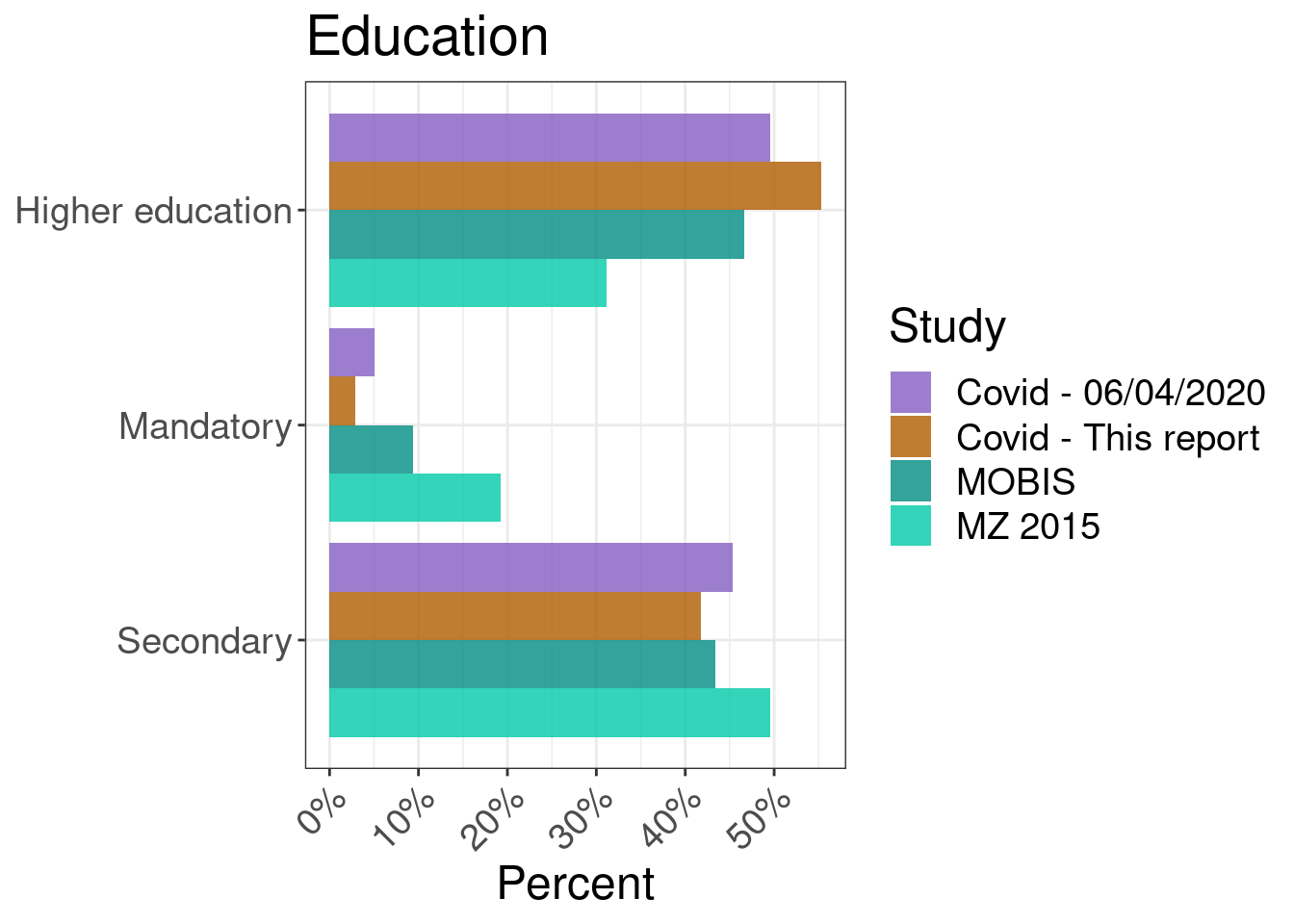
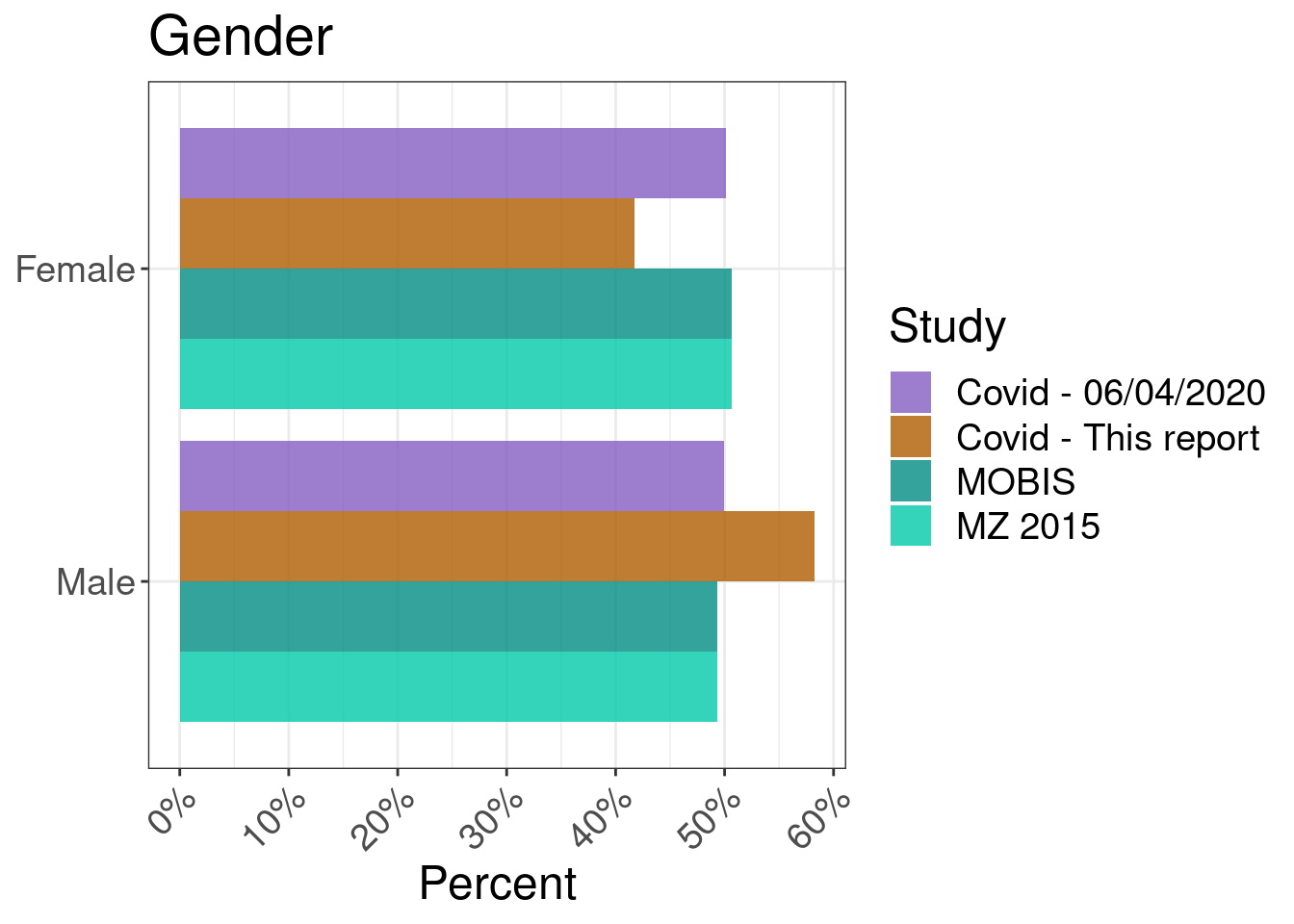
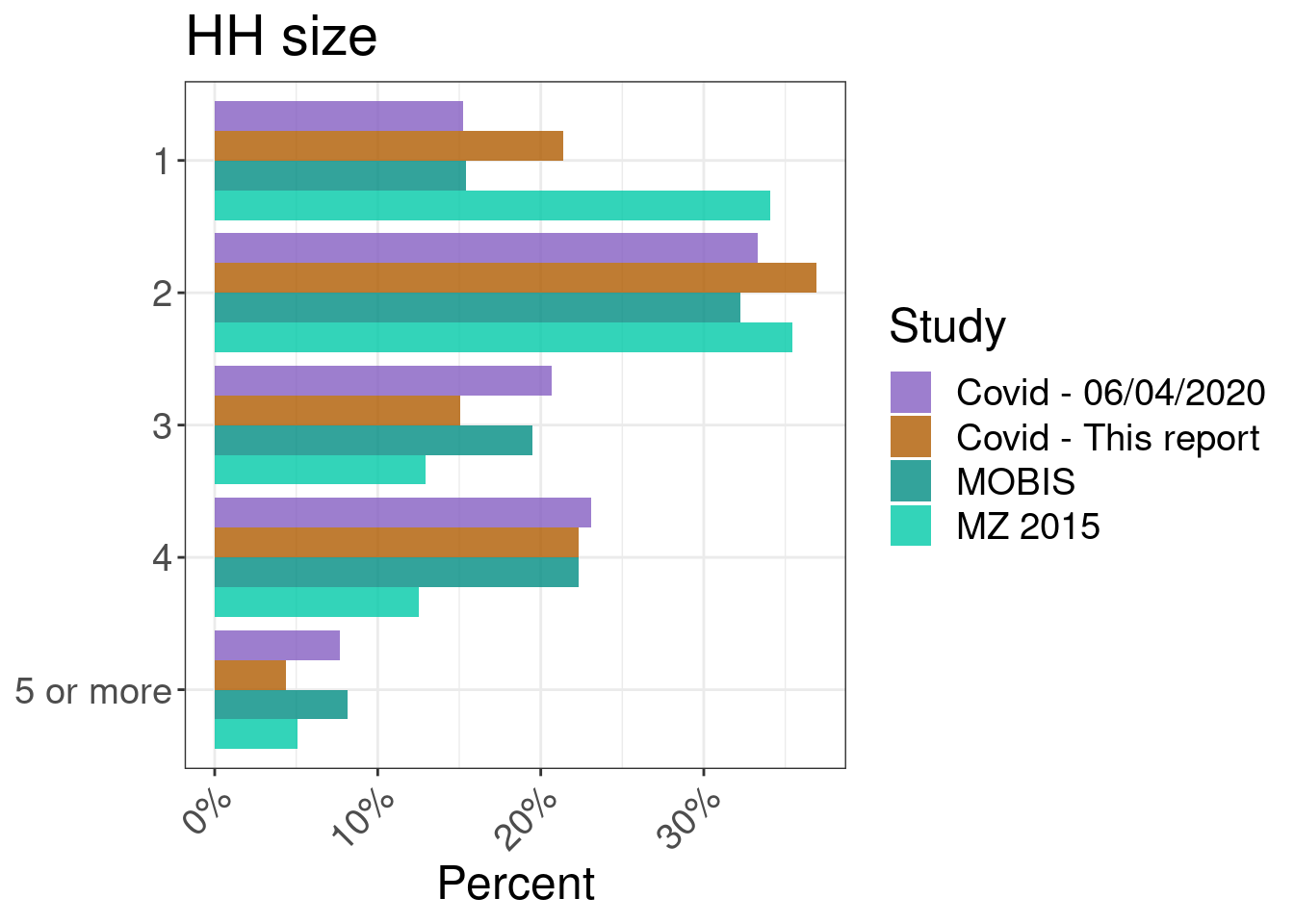
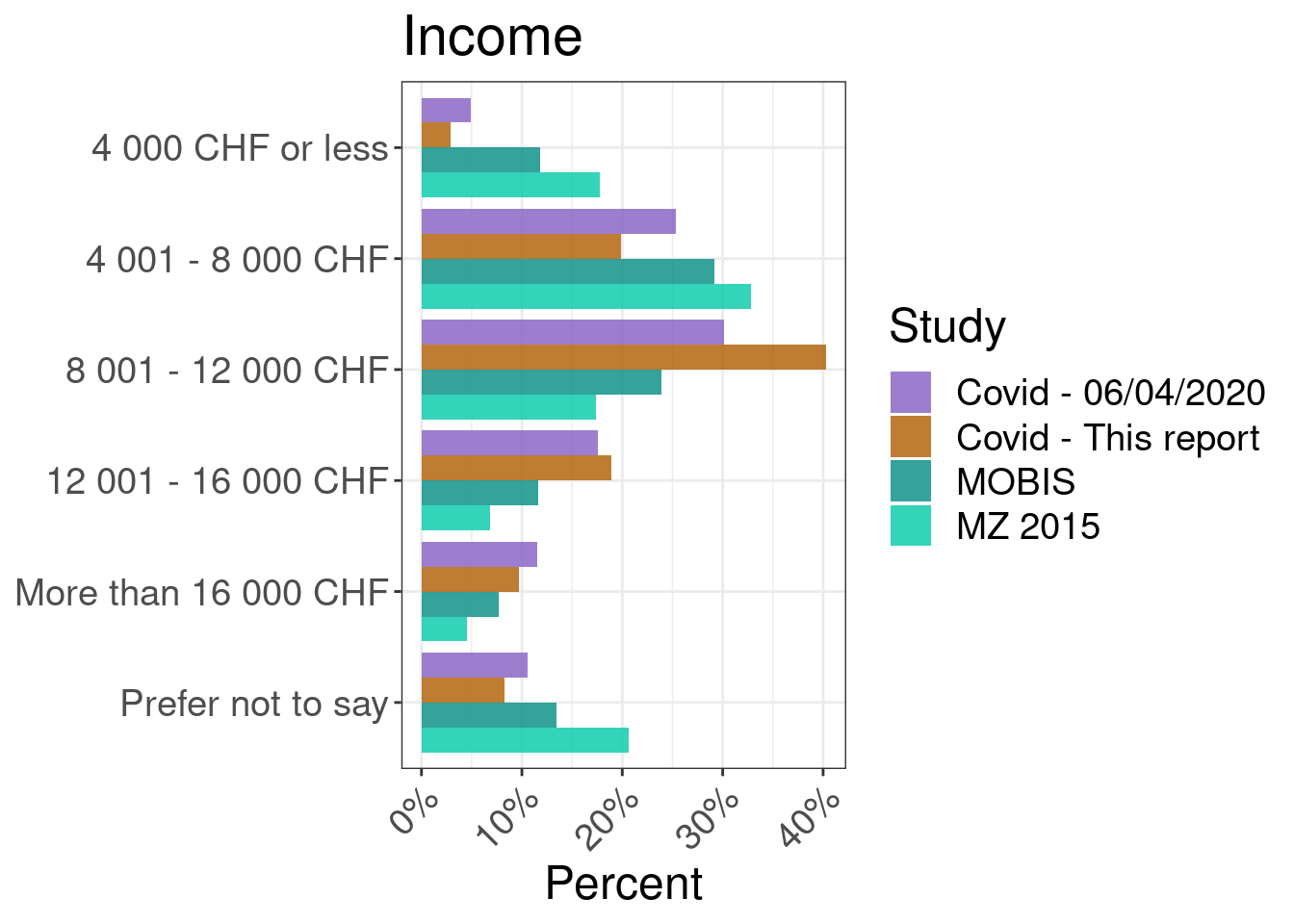
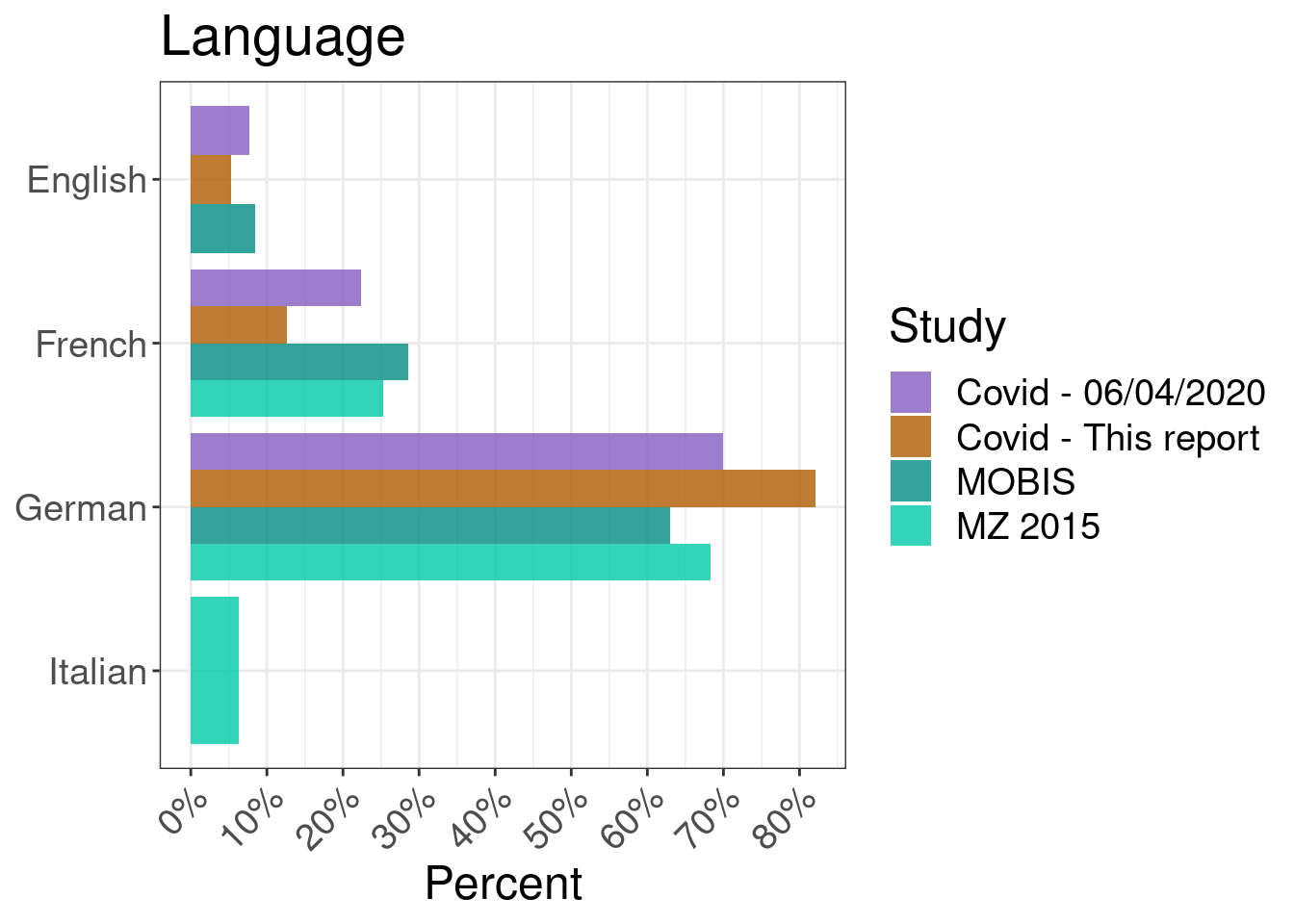
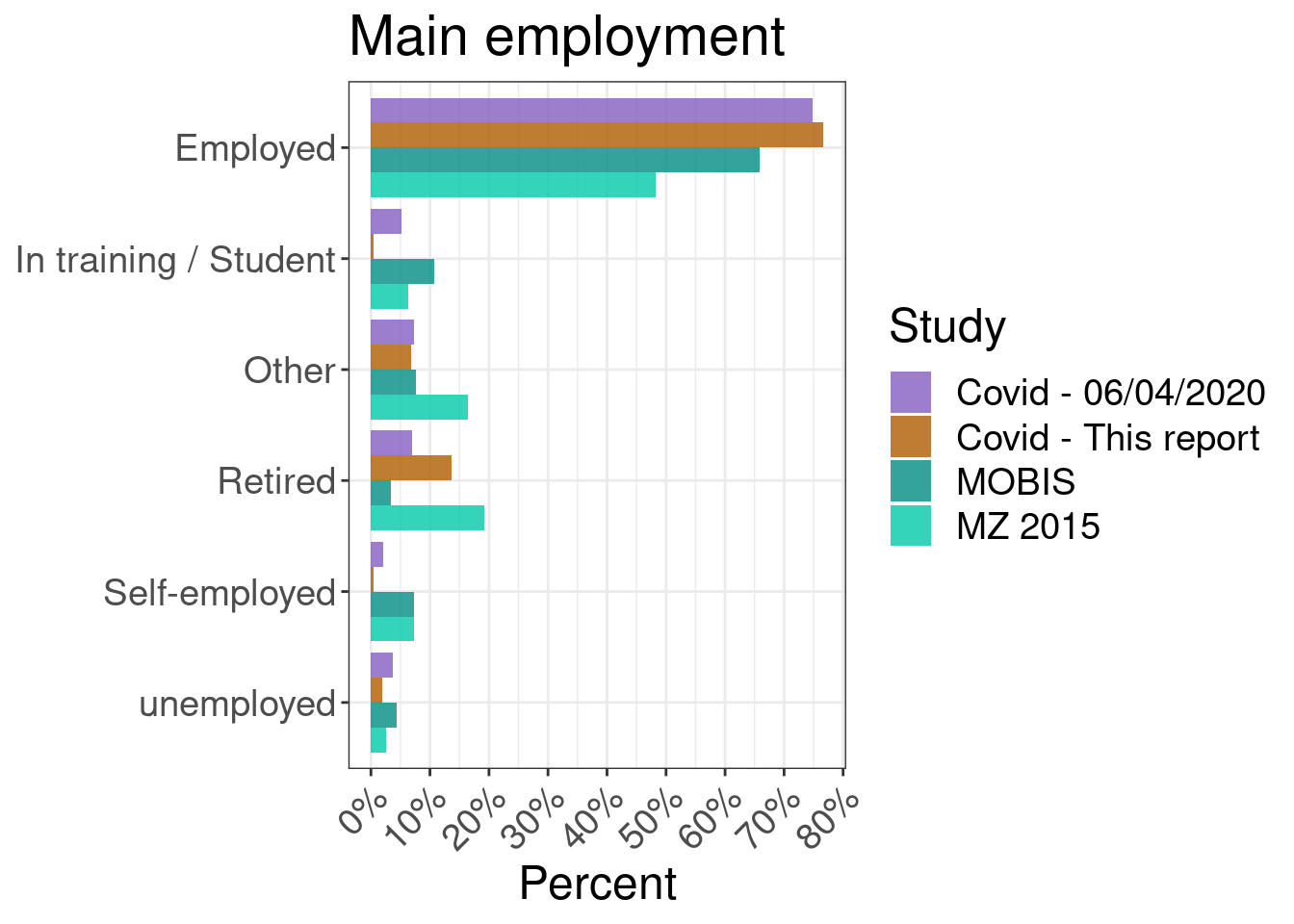
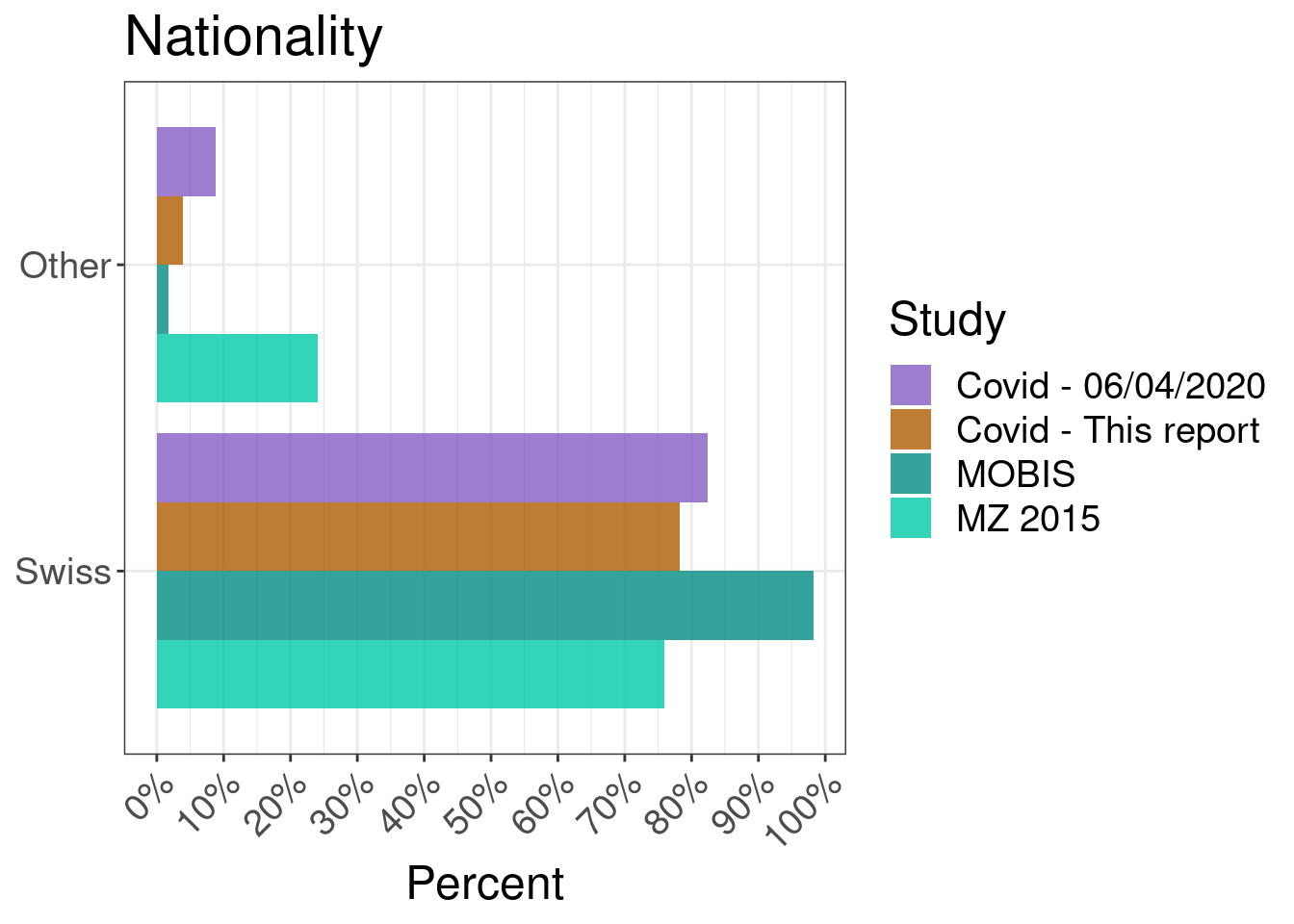
| N | % | N | % | N | % | |
|---|---|---|---|---|---|---|
| Aargau | 94 | 5.1 | 7 | 3.4 | 4,325 | 7.6 |
| Basel-Landschaft | 211 | 11.5 | 28 | 13.6 | 1,940 | 3.4 |
| Basel-Stadt | 40 | 2.2 |
|
|
1,555 | 2.7 |
| Bern | 214 | 11.6 | 26 | 12.6 | 7,244 | 12.7 |
| Fribourg | 10 | 0.5 |
|
|
1,942 | 3.4 |
| Geneva | 136 | 7.4 | 12 | 5.8 | 3,062 | 5.4 |
| Other | 13 | 0.7 | 14 | 6.8 | 18,491 | 32.4 |
| Schwyz | 20 | 1.1 |
|
|
1,005 | 1.8 |
| Solothurn | 23 | 1.2 |
|
|
1,813 | 3.2 |
| Vaud | 318 | 17.3 | 18 | 8.7 | 5,303 | 9.3 |
| Zurich | 750 | 40.7 | 101 | 49.0 | 10,410 | 18.2 |
20 Sample weighting
In order to account for the fluctuating size and composition of the sample, participant weights have been calculated and applied for each week of MOBIS-Covid Study (including the weeks in the baseline period). Hence, the results are corrected for weeks where more participants from a certain demographic group started or stopped tracking. The weighting was performed against the original 21,571 participants who completed the introductory questionnaire in the MOBIS Study using IPF (Iterative Proportional Fitting) using the following variables: age, gender, income, education, mobility tool ownership and accessibility. The weighting of the data did not lead to large changes in the results.
21 Updated conclusions
Since commencing in spring 2020, the MOBIS:COVID-19 tracking study has recorded 1,875,948 person-trips as of 2023-10-09. It includes three small surveys about the work situation and the health of the participants. A maximum of 1,370 persons participated and an average of 484. We use the Catch-my-Day smartphone app, which is based on MotionTag technology. The sample is roughly comparable in socio-demographics to the latest federal 2015 Mikrozensus, but for a bias towards higher income season-ticket owning better educated males. The denser parts of the German and French speaking parts of the country are also overrepresented in our sample. The conclusions are based on weighted results which ensure that the sample matches the representative sample of around 20,000 invited persons in the original MOBIS study. The weights are calculated based on age, sex, education, income, mobility tool ownership and the accessibility level of a person’s home location.
Our study is not the only source for Switzerland which traces the impact of the pandemic and of the measures implemented to contain it. The Intervista panel has been funded by different federal offices during these months. The available Google data has the advantage of being available worldwide, but only for high-level geographies and without any socio-demographics. We can draw on a more detailed self-description of the participants using their socio-demographics and their attitudes.
The central observations focus on the ongoing acceptance of “Working from Home (WFH)” or in German “Home-office” and the modal shift in the recovery of the trip volumes and in the miles driven. Equally important is the comparatively much lower social selectivity of the impacts in Switzerland.
The share of active, i.e. mobile, days shows the anticipation of the lockdown and then the recovery and stabilization to about 80% in August 2020. This is substantially below the 90+% share, which one can expect (Madre et al., 2007). This lower share must be a mixture of WFH, persons furloughed or newly unemployed. During the pandemic, the working from home policy has been present in various forms as either a recommendation or requirement, with a period of relaxation during the summer of 2021. However, by then the practice was well established. There have been prominent announcements of firms not calling staff back to the office, e.g. Facebook, twitter, PSA, but equally prominent ones calling their employees back, e.g, Stadler. If mobilized, this suppressed demand would meet a road system where the average speeds are again at pre-pandemic levels – conditions which could lead to increased congestion. The speed levels are explained by the low public transport shares and an unchanged distance for those who drive.
The population has shifted away from space-efficient large vehicles, as buses, trams and trains remain unpopular. Usage was down between 40% to 60% of the 2019 ridership after a near complete avoidance in the first weeks after the lockdown. On average, car travel fully recovered during 2020, before collapsing again, but less severely during the second wave over the winter of 2020/21. Equally, walking has fully recovered. It is worth noting that walking levels never dropped in the same way as for other modes.
The surprise was, and still is the increased bicycle usage backed up by a boom in cycle acquisition during the good-weather months. While the increase seemed initially to be mostly a fitness, leisure boom, the recent imputation of the trip purposes has shown that the cycle gained for all purposes with leisure and shopping the most prominent ones. Commuting to work by bike also increased, but not as strongly (about 40% versus 60-80% for the other purposes). The new freedom in time allocation is visible in the cycling for leisure during the day. Regression-based analyses (soon to be part of this report) indicate that the modal shifts are not driven by weather. The results are qualitatively similar when controlling for temperature and precipitation.
Finally, the experience of the COVID-19 period confirms the results of earlier telecommuting experiments (Pendyala et al., 1991). They had shown that the total mileage is not reduced, as the persons used the liberated time for other travel. Here, the Kurzarbeiter (furloughed) track the trends and actually travel a bit more than the other workers. Those working from home do travel less than those who have to go to their workplaces, but the difference is not nearly as large as one would expect.
The inclusion of the new LINK recruited participants did not change the trends seen before. This highlights the overall quality of the study and of its sample.
References:
Madre, J.-L., K.W. Axhausen and W. Brög (2007) Immobility in travel diary surveys, Transportation, 34 (1) 107-128.
Pendyala, R.M., Goulias, K.G. and R. Kitamura (1991) Impact of telecommuting on spatial and temporal patterns of household travel, Transportation, 18 (4) 383-409.


